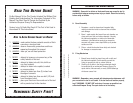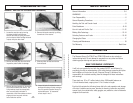
-15-
-4-
© Copyright 2004 SIMPSON STRONG-TIE COMPANY INC.
© Copyright 2004 SIMPSON STRONG-TIE COMPANY INC.
1. FASTENER SELECTION
1. The PTM-27 and PTM-27HD are designed to set three types of
fasteners, drive pins, threaded studs and special assemblies such
as drive pins with pre-assembled washers, conduit clips and
ceiling clips.
2. All Simpson Strong-Tie fasteners are manufactured from high
carbon steel, especially heat treated to allow ductility yet hard
enough to penetrate concrete or structural steel.
3. Drive pins vary in length from 1/2" to 3" shank length and are
.300 inch, 5/16" or 8mm-head diameter. The PTM-27 and
PTM-27HD have a capacity of 3 inches. Drive pins are used to
directly fasten suitable work materials to a suitable base material.
4. Threaded studs vary in overall length from 3/4" to 2-1/2" with
many combinations of thread length or shank length. Threads are
1/4-20 NC. Threaded studs are generally driven directly into the
base material with the work material attached subsequently with
a nut and washer.
5. Drive pins assembled with washers generally vary in length from
1" to 3" and are assembled with washers from 3/4" diameter to
1-1/2" diameter. Conduit clips are generally available in 1/2" TW,
3/4" TW and 1" TW with either a 1" or 1-1/4" drive pin assembled.
Ceiling clips are assembled with 1" or 1-1/4" drive pins and
although generally used for hanging suspended ceilings they can
be used for a variety of hanging applications.
6. Fastener penetration into concrete should be roughly 6 to 8 times
the shank diameter; higher for low psi concrete and lower for high
psi concrete, for maximum holding power.
7. When fastening into steel with a drive pin add the thickness of the
work material to the thickness of the steel plus 1/4" for the point to
fully penetrate. For threaded studs select one that has a shank
length to penetrate the steel 1/4 inch and sufficient thread length
for the work material plus a washer and nut.
8. Always use the spall guard where space allows as it helps hold the
tool perpendicular to the work surface as well as offering additional
safety to the use of the tool.
SELECTING FASTENERS AND LOADS IMPORTANT SAFETY INFORMATION
BASE MATERIAL SUITABILITY
Before fastening into any material, give it the center punch test. Using the
fastener as a punch, and a hammer, strike a solid blow to the actual material
you wish to fasten into. If the point of the fastener is blunted the material is too
hard and is unsuitable. If the material cracks or shatters it is too brittle and is
unsuitable. If the fastener sinks into the material with the hammer blow, the
material is too soft and is unsuitable.
✓ If the material is too hard the fastener can ricochet and possibly escape,
striking you or bystanders and cause serious injury or death.
✓ If the material is too soft the fastener can pass completely through and
strike someone on the other side causing serious injury or death.
✓ REMEMBER - If you can hammer a fastener into the base material do not
attempt to drive it with any powder-actuated tool.
SAFETY STARTS WITH YOU!
Your safety and the safety of those around you should always be kept the
foremost thought in the mind of every powder actuated tool operator. Consider
that the least powerful load used in powder actuated stud drivers produce
approximately 10 times the power of a .22 caliber long rifle cartridge. Respect
this power as you would your chain saw, your lawn mower, and your rifle.
Keep safety in mind and safety will mind you.
Reliable training is necessary if you want to be a good chemist, engineer,
architect, machinist or carpenter. The only absolutely reliable training for powder
actuated tool operator lies in his or her ability to absorb and abide by the
instruction and safety precautions for each and every tool operated.
For absolute reliable training, rely on yourself.
Think of safety first!
WARNING












